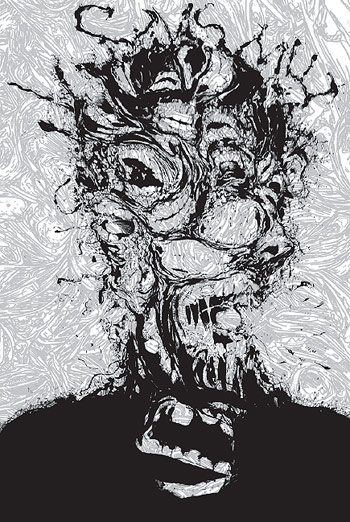![]()

Preview (Robin Mackay's introduction to this volume)
Finally the promised issue of Collapse on concept-horror:
We are delighted to announce that Collapse Volume IV will be published May 2008 and is now available for advance purchase online.
Collapse IV features a series of investigations by philosophers, writers and artists into Concept Horror. Contributors address the existential, aesthetic, theological and political dimensions of horror, interrogate its peculiar affinity with philosophical thought, and uncover the horrors that may lie in wait for those who pursue rational thought beyond the bounds of the reasonable.
George Sieg's Infinite Regress into Self-Referential Horror demonstrates the simultaneously cognitive, existential and political nature of Horror, through a conceptual investigation of the primacy of victimhood for the affect of horror, tracing its origins to the Zoroastrian concept of Druj.
In The Shadow of a Puppet-Dance, James Trafford tracks weird fiction writer Thomas Ligotti's anticipation of the radical thesis of neurophilosopher Thomas Metzinger's book Being No-One: namely, that 'nobody ever was or had a self'.
In Thomas Ligotti's own contribution to the volume, Thinking Horror, he takes up the work of obscure Norwegian philosopher Peter Zapffe, among others, to take an unflinching journey into the depths of pessimistic thought.
As a counterpoint to Ligotti's deflation of human hubris, Oleg Kulik, the internationally-acclaimed Ukrainian contemporary artist known for his disturbing investigations into the borders between life and death, human and animal, contributes his photographic series Memento Mori: Dead Monkeys.
Eugene Thacker's Nine Disputations on Theology and Horror gives a detailed and penetrating account of the 'teratological noosphere', discussing the way in which a certain horror has perenially accompanied the concept of 'life', from Aristotle to Lovecraft.
Novelist Michel Houellebecq is well-known for his evocation of the horror that dwells within the banalities of contemporary life. His poems, of which a selection are translated into English here for the first time, distil his powerful vision into translucid moments of dread.
Jake and Dinos Chapman, the notorious Brothers Grim of the British artworld contribute a set of drawings created exclusively for Collapse. The cartoon-horror of I Can See continues their investigations into the connection between laughter and horror through the programmatic impoverishment of the aesthetic.
In the third of a 'trilogy' of essays published in Collapse, Spectral Dilemma, Quentin Meillassoux reveals some of the ethical consequences of his deduction of the 'necessity of contingency', through an examination of the problem of 'infinite mourning' for the dead.
Kristen Alvanson's photographs, at once repellent and fascinating, of preserved specimens of deformed and mutated animals and humans, are accompanied by a text which discusses Paré's sixteenth-century treatise which makes of taxonomy itself something monstrous, as demonstrated in Alvanson's diagrammatic presentation of the Arbor Deformia.
German artist Todosch's meticulous drawings seem to depict varieties of heterogenous slime in the process either of disintegration or coagulation, making them a perfect companion to Iain Hamilton Grant's Being and Slime. This untimely excavation of nineteenth-century naturephilosopher Lorenz Oken - according to whom the generation of the universe from a 'primal zero' corresponds to its coagulation from a 'primaeval mucus' - puts an entirely new slant on Badiou's notion of 'founding on the void'.
Benjamin Noys meditates on Lovecraft and the real, revealing that the most abyssal of Horrors is Horror Temporis.
In The Corpse Bride:Thinking with Nigredo, Reza Negarestani shows how Aristotle and Plotinus both unlock and dissimulate the ontological mechanism expressed by an unspeakable form of Etruscan torture.
Canadian artist Steven Shearer contributes a new series of his Poems - striking graphical pieces created through a manipulation of the nihilistic and extreme titles and lyrics of death-metal bands.
China Miéville, better known for his bestselling weird fiction novels, writes on M.R.James and the Quantum Vampire, interrogating the dyad of the weird and the hauntological, and introducing us to a new fearsome creature from his arsenal ... behold the Skulltopus!
Czech art collective Rafani present their cycle Czech Forest, an adaptation of folk-tale imagery which presents a very modern tale of warcrime and revenge from the end of WWII.
Graham Harman returns to Collapse with On the Horror of Phenomenology: Lovecraft and Husserl. In a polemical defence of 'weird realism', Harman demonstrates that philosophical thought has more in common with weird and horror fiction than it might like to admit.
Singular Agitations and a Common Vertigo, Keith Tilford's series of images, deftly disintegrated objects with more than a hint of 'pulp', anticipate and shadow Harman's invocation of the weird inner life of objects.
Collapse Volume IV // Ed. R. Mackay // May 2008 // 390pp // Limited Edition 1000 copies // ISBN 978-0-9553087-3-4 // £9.99
More details Here.
Pre-order Here.